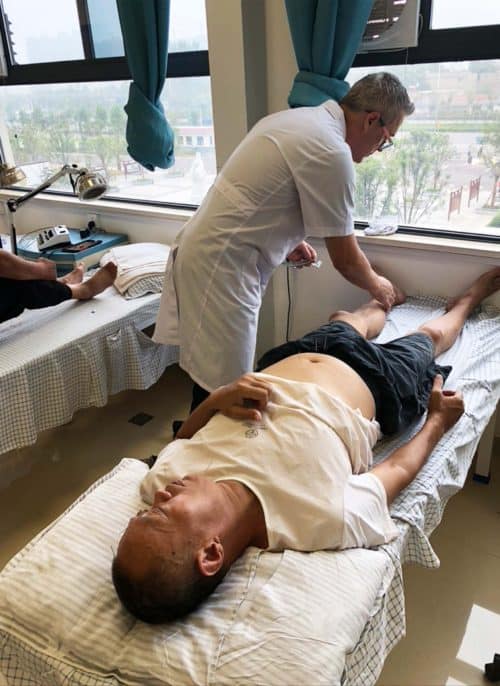Acupuncture for ulcerative colitis
OBJECTIVE:
To compare the clinical efficacy on chronic ulcerative colitis between electroacupuncture (EA) combined with acupoint sticking therapy (AST) and western medicine.
Abdominal Pain

Dr. Tony Willcox at in BoZhou, China treating patients for digestive discomfort.
METHODS:
Researchers randomly assigned ninety cases to two groups: the EA + AST group and the western medication group, with 45 cases each. The EA + AST group received treatment at acupuncture points (1) Zhongwan (CV 12), Tianshu (ST 25), Guanyuan (CV 4), Qihai (CV 6) and (2) Shangjuxu (ST 37), Pishu (BL 20), Dachangshu (BL 25), Zusanli (ST 36), alternating between electroacupuncture (EA) and acupuncture stimulation therapy (AST). The western medication group took Mesalazine orally.
Initially, clinicians evaluated symptoms and conducted colonoscopic examinations before treatment. Subsequently, they repeated these assessments after treatment. Finally, they compared the efficacy between the groups.
RESULTS:
In EA + AST group, the total effective rate of clinical symptoms was 91.1% (41/45) and the total effective rate of the colonoscopic improvements in mucosal lesions was 84.4% (38/45), which were all superior to those (73.3%, 33/45; 66.7%, 30/45) in medication group (both P
CONCLUSION:
For acupuncture in treating ulcerative colitis, the combination of electroacupuncture and acupoint sticking therapy significantly enhances clinical symptoms and colonoscopic mucosal lesions in patients. Moreover, its efficacy surpasses that of Mesalazine.
Resources
1- By Acupuncture-Moxibustion Department, Xiangcheng Municipal Hospital of TCM, Xiangcheng 466200, Henan Province, China. All rights reserved.
– http://www.ncbi.nlm.nih.gov/pubmed/20886789
Dr. Tony Willcox honed skills at Yueyang, Shuguang, Anhui University, Jinxiang, and Bozhou hospitals in China. He treats patients, leveraging China’s vast population and reliance on traditional Chinese medicine. Acupuncture helps restore and boost patient health and wellness.
